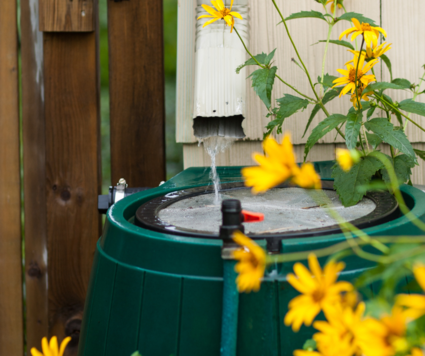WATER QUALITY IMPROVEMENTS

Rainwater Harvesting: Simple Steps to Installing a Rain Garden
In preparation for the rainy season (October 1st through April 30th), there’s no better time to take advantage of the benefits of harvesting rainwater and planting a rain garden. Rainwater harvesting is the collection, storage, and re-use of natural rainfall. Not only will you be getting clean and free water for use in your yard, but you will also be conserving water and protecting our waterways and ocean from polluted runoff. Reducing runoff from roofs, driveways, and sidewalks keeps harmful pollutants such as pesticides/fertilizers, trash, pet waste, and automobile fluids from flowing into our storm drains. Here in San Diego County, water in storm drains is not treated before it reaches our local creeks, rivers, and the ocean.
|
Rainwater Harvesting and Rain Gardens
Rainwater Harvesting doesn’t have to be complicated! Even simple actions like redirecting your downspout to landscaped areas will help save water and prevent stormwater pollution. Review these 5 Ways to Save Water and Money by Rainwater Harvesting to learn more. On the County of San Diego’s Waterscape Rebate Program webpage you’ll find information on currently available rebates, how to calculate your rain harvest volume, and how to start your rebate application process. Solana Center for Environmental Innovation also has a rain barrel/rebate webpage.
Rain Gardens – One of the most effective approaches to harvesting rainwater is to install a rain garden with vegetation in a low spot in your yard where water naturally collects. A rain garden will not only beautify your yard but will also remove pollutants from stormwater runoff. Installing other natural landscape capture features like a rock garden or dry riverbed can also help to act as a water retention basin for plants to use later on. The Sustainable Landscapes Program has put together an excellent guide for taking a watershed approach to landscaping. You can find the steps related to rain gardens in the Water section starting on page 38. Below are some of the key steps to get you started:
-
Planning – Choose a downslope area on your property, preferably in partial or direct sunlight, that naturally receives water from roofs or overflow areas. As a rule of thumb, your rain garden should be large enough to hold one inch of water. Water can be easily harvested from a roof, driveway, or other hard surface and directed toward the garden using downspout extensions, underground pipes, or vegetated swales.
-
Plant selection – Plant native plants that are well-adapted to seasonal, short-duration water supply, and long periods of drought. Use different types of plants for the sides/slopes of a rain garden, the base, and the top. See these lists of plant options for California climates and the County’s Best Management Practices (BMP) flyer for California-friendly vegetation.
-
Planting – Determine your soil type and adjust soil amendments to ensure proper infiltration. Apply mulch (2 to 4 inches initially) and water plants until they become established and re-apply mulch annually until plants have matured.
-
Maintenance – Keep gutters, downspouts, and the lowest areas of your rain garden free from debris, and at the end of the rainy season, remove accumulated sediment. Keep plants healthy to prevent erosion and block erosion rills. Clean and repair any channels, berms, or moats.
For more information on other ways to prevent stormwater pollution, visit the County of San Diego’s Watershed Protection Program webpage where you’ll find a wealth of educational resources, flyers, and helpful bulletins for both residents and businesses.

|